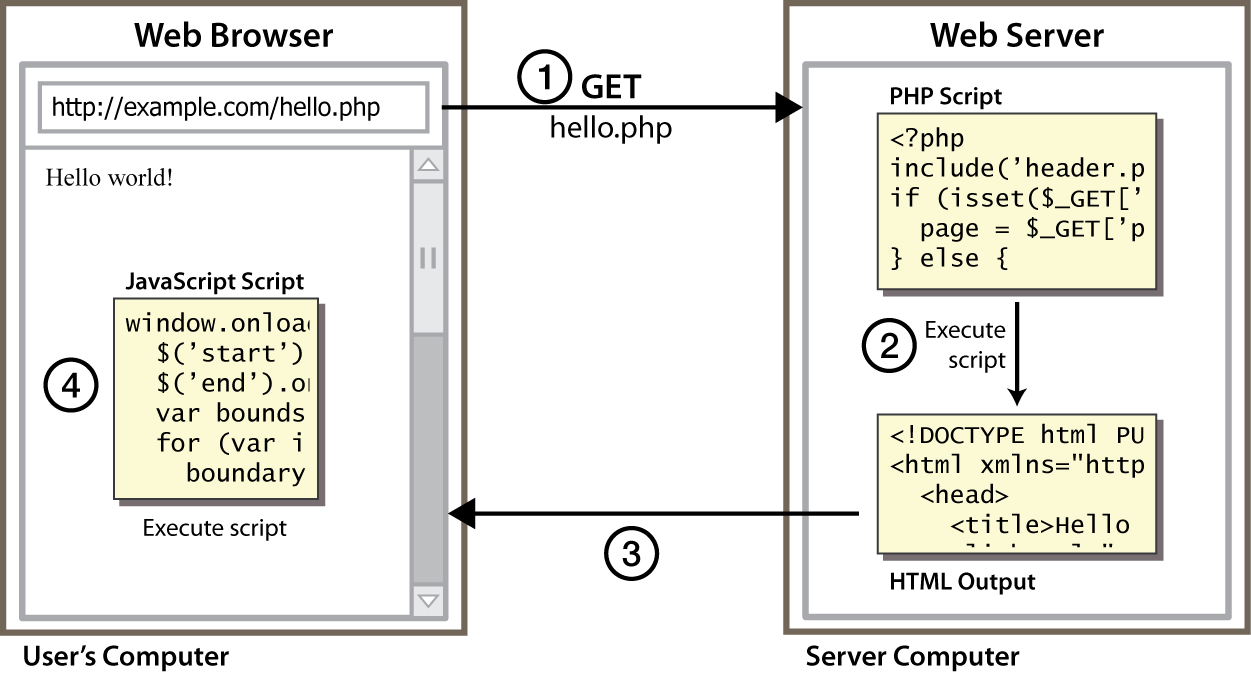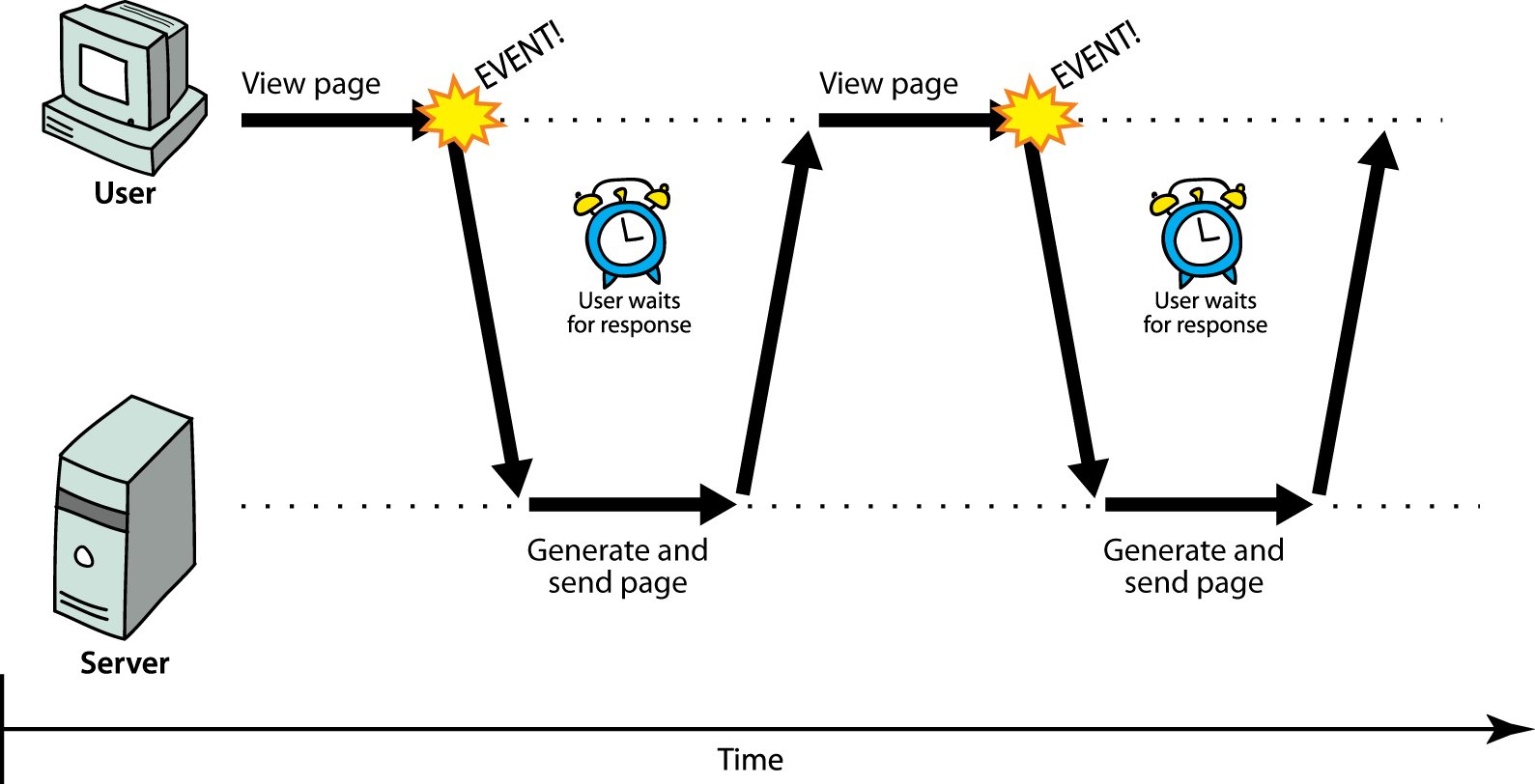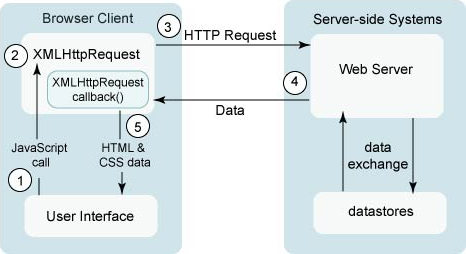Web Programming Step by Step
HTTP, HTML and Javascript Basics
Except where otherwise noted, the contents of this presentation are Copyright 2010 Marty Stepp and Jessica Miller.
Overview
- Modern Web browsers
- HTTP
- HTML
- Javascript and AJAX
- jQuery
Modern Web Browsers
- Contacts a web-server via HTTP requesting a resource (via its URI)
- This resource can be an HTML page (to be rendered by the browser), images, javascript or other files
- Often, the web browser requests and loads an HTML page which then proceeds to request other resources
Uniform Resource Locator (URL)
- an identifier for the location of a document on a web site
-
a basic URL:
http://www.aw-bc.com/info/regesstepp/index.html ~~~~ ~~~~~~~~~~~~~ ~~~~~~~~~~~~~~~~~~~~~~~~~~ protocol host path
-
upon entering this URL into the browser, it would:
- ask the DNS server for the IP address of
www.aw-bc.com - connect to that IP address at port 80
- ask the server to
GET /info/regesstepp/index.html - display the resulting page on the screen
- ask the DNS server for the IP address of
More advanced URLs
-
anchor: jumps to a given section of a web page
http://www.textpad.com/download/index.html#downloads
- fetches
index.htmlthen jumps down to part of the page labeleddownloads
- fetches
-
port: for web servers on ports other than the default 80
http://www.cs.washington.edu:8080/secret/money.txt
-
query string: a set of parameters passed to a web program
http://www.google.com/search?q=miserable+failure&start=10
- parameter
qis set to"miserable+failure" - parameter
startis set to10
- parameter
Hypertext Transport Protocol (HTTP) (1.2.3)
- the set of commands understood by a web server and sent from a browser
-
some HTTP commands (your browser sends these internally):
GET filename: downloadPOST filename: send a web form responsePUT filename: upload
-
simulating a browser with a terminal window:
$ telnet www.cs.washington.edu 80 Trying 128.208.3.88... Connected to 128.208.3.88 (128.208.3.88). Escape character is '^]'. GET /index.html <!DOCTYPE HTML PUBLIC "-//W3C//DTD HTML 4.0 ..."> <html> ...
HTTP error codes
- when something goes wrong, the web server returns a special "error code" number to the browser, possibly followed by an HTML document
- common error codes:
Number Meaning 200 OK 301-303 page has moved (permanently or temporarily) 403 you are forbidden to access this page 404 page not found 500 internal server error complete list
Web languages / technologies (1.2.4)
- Hypertext Markup Language (HTML): used for writing web pages
- Cascading Style Sheets (CSS): stylistic info for web pages
- PHP Hypertext Processor (PHP): dynamically create pages on a web server
- JavaScript: interactive and programmable web pages
- Asynchronous JavaScript and XML (Ajax): accessing data for web applications
- eXtensible Markup Language (XML): metalanguage for organizing data
- Structured Query Language (SQL): interaction with databases
Hypertext Markup Language (HTML) (2.1.1)
- describes the content and structure of information on a web page
- not the same as the presentation (appearance on screen)
- surrounds text content with opening and closing tags
- each tag's name is called an element
- syntax:
<element>content</element> - example:
<p>This is a paragraph</p>
- syntax:
- most whitespace is insignificant in HTML (ignored or collapsed to a single space)
- we will use a stricter, more standard version called XHTML
Structure of an HTML page (2.1.2)
<html>
<head>
information about the page
</head>
<body>
page contents
</body>
</html>
- the header describes the page and the body contains the page's contents
- an HTML page is saved into a file ending with extension
.html
Links:
<a>
(2.1.4)
links, or "anchors", to other pages (inline)
<p> Search <a href="http://www.google.com/">Google</a> or our <a href="lectures.html">Lecture Notes</a>. </p>
- uses the
hrefattribute to specify the destination URL- can be absolute (to another web site) or relative (to another page on this site)
- anchors are inline elements; must be placed in a block element such as
porh1
HTML Tag Reference
More information about HTML tags can be found at:JavaScript (7.1)
- Javascript is a lightweight programming language ("scripting language")
- used to make web pages interactive
- insert dynamic text into HTML (ex: user name)
- react to events (ex: page load user click)
- get information about a user's computer (ex: browser type)
- perform calculations on user's computer (ex: form validation)
- a web standard (but not supported identically by all browsers)
- NOT related to Java other than by name and some syntactic similarities
Client-side scripting (7.1.1)

- client-side script: code runs in browser after page is sent back from server
- often this code manipulates the page or responds to user actions
Linking to a JavaScript file:
script
<script src="filename" type="text/javascript"></script>
<script src="example.js" type="text/javascript"></script>
scripttag should be placed in HTML page'shead- script code is stored in a separate
.jsfile - JS code can be placed directly in the HTML file's
bodyorhead(like CSS)- but this is bad style (should separate content, presentation, and behavior)
Event-driven programming

- JS programs have no
main; they respond to user actions called events - event-driven programming: writing programs driven by user events
Variables and types (7.2.1, 7.2.3)
var name = expression;
var age = 32; var weight = 127.4; var clientName = "Connie Client";
- variables are declared with the
varkeyword (case sensitive) - types are not specified, but JS does have types ("loosely typed")
Number,Boolean,String,Array,Object,Function,Null,Undefined- can find out a variable's type by calling
typeof
JavaScript functions
function name() {
statement ;
statement ;
...
statement ;
}
function myFunction() {
alert("Hello!");
alert("How are you?");
}
- the above could be the contents of
example.jslinked to our HTML page - statements placed into functions can be evaluated in response to user events
Event handlers
<element attributes onclick="function();">...
<button onclick="myFunction();">Click me!</button>
- JavaScript functions can be set as event handlers
- when you interact with the element, the function will execute
onclickis just one of many event HTML attributes we'll use
-
but popping up an
alertwindow is disruptive and annoying- A better user experience would be to have the message appear on the page...
Synchronous web communication (10.1)

- synchronous: user must wait while new pages load
- the typical communication pattern used in web pages (click, wait, refresh)
Asynchronous web communication

- asynchronous: user can keep interacting with page while data loads
- communication pattern made possible by Ajax
A typical Ajax request

- user clicks, invoking an event handler
- handler's code creates an
XMLHttpRequestobject XMLHttpRequestobject requests page from server- server retrieves appropriate data, sends it back
XMLHttpRequestfires an event when data arrives- this is often called a callback
- you can attach a handler function to this event
- your callback event handler processes the data and displays it
jQuery
- Browsers have inconsistencies in their Javascript implementations, making development across different browsers painful
- jQuery is a Javascript library which wraps many commonly used tasks such as retrieving elements, sending AJAX requests among others providing a common interface for all browsers
jQuery simple example
adding an "on click" alert to HTML element with id="myButton"Before jQuery:
var button = document.getElementById("myButton");
button.onclick = function() { alert("hi there!"); }
With jQuery:
$("#myButton").click(function() { alert("hi there!"); });
jQuery a more complex example
Making an AJAX requestBefore jQuery:
// Request "page.html" via a "GET" request asynchronously
// (This will not work in IE prior to version 9)
var ajax = new XMLHttpRequest();
ajax.open("GET", "page.html", true);
// Wait until page loads and alerts the request page source
ajax.onreadystatechange = function() {
if (ajax.readyState == 4) { // AJAX page loaded
alert(ajax.responseText);
}
}
// Sends the request to the server
ajax.send();
jQuery a more complex example made easy
With jQuery:
// Gets "page.html" and adds a "completed" callback
// which once again alerts the page source
$.get("page.html", function(data, status, ajax) {
alert(data);
});
More information on jQuery can be found at http://docs.jquery.com/

